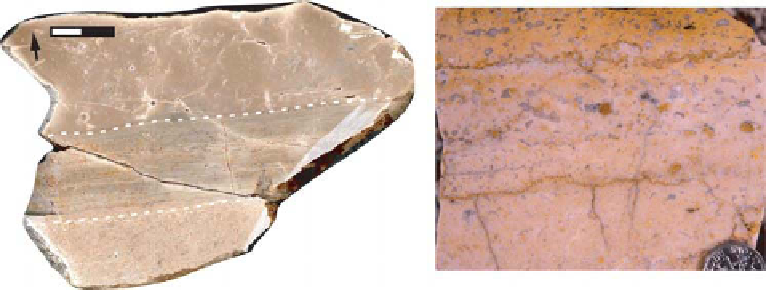Geology Reference
In-Depth Information
being capped by vadose dolomitic caliche fabrics,
Mendola Pass cycles are laminite-capped cycles,
similar in many ways to the upper Triassic Dolomia
Principale and Lofer cycles of the Dachstein
Limestone (Fischer, 1964; Bosellini & Hardie,
1985; Goldhammer
et al
., 1990; Haas, 1994, 2004;
Cozzi
et al
., 2005). The typical Mendola Pass cycle
has an erosive base consisting of millimetre- to
centimetre-scale fl at laminated intraclasts ripped
up from the underlying cycle cap. Erosion of cycle
tops is interpreted to be the result of transgressive
reworking or reworking of the substrate during
high-energy events prior to the reinitiation of
carbonate sedimentation after fl ooding. Similar
base-of-cycle intraclastic breccias can be observed
in the laminite-capped cycles of the Dolomia
Principale and the Dachstein Limestone, where
they have also been interpreted as transgressive or
related to storm reworking of the substrate (Fischer,
1964; Bosellini & Hardie, 1985; Cozzi, 2002).
Erosive bases grade upward into a dolomitized
peloidal mudstone-wackestone with fi ne bio-
clastic debris and intermittent lenses of dasycla-
dacean grainstone (storm beds), interpreted to
have been deposited within a shallow (<10 m)
restricted lagoon. Work done on Holocene depos-
its by Ginsburg
et al
. (1977) and Shinn (1986)
described offshore sediment in the modern
environments of Andros Island, Bahamas, that
closely matches the description of the peloidal
wackestones observed in Mendola Pass cycles.
Cores taken 4 km offshore from the tidal fl ats of
Andros Island show well-churned, burrowed
sediments that notably lack recognizable physical
sedimentary structures (Hardie & Ginsburg, 1977).
Texturally, these sediments may be described as
highly bioturbated, grey pelletal-peloidal mud-
stone-wackestones containing benthic foramin-
ifera and skeletal debris (Shinn, 1986). The modern
shallowing-upward tidal-fl at cycle of Enos &
Perkins (1979) and Shinn (1986) assigns this sub-
facies to the subtidal realm, up to approximately
10 m deep. A similar interpretation applies to the
peloidal wackestone facies within the Mendola
Pass cycles, with the caveat that a general lack of
diversity of faunal remains may be indicative of
restriction.
Subtidal wackestone facies within Mendola
cycles characteristically coarsen up to a dasycla-
dacean packstone-grainstone prior to being capped
by microbial laminites (Fig. 4). Dasycladacean
grainstones are interpreted as evidence of shallow-
water (perhaps intertidal) reworking resulting
from sedimentary fi ll of accommodation space
and aggradation into a comparatively energetic
depositional environment. This facies may rep-
resent a shallow subtidal depositional setting
within the infl uence of high-energy events (e.g.
storms) that reworked algae into semi-articulated
bioclasts.
All Mendola Pass cycles are capped by
millimetre-scale, crinkly laminated mudstone-
wackestone with intercalated discontinuous
layers of intraclastic and bioclastic grainstone.
(a)
(b)
cm
L2
01 2
M3
M2
L1
M1
Mendola
Latemar
Fig. 4.
Polished hand specimens of cycle tops. (a) Mendola Pass (b) Latemar section. Mendola subfacies include: M1,
dasycladacean algal packstone; M2, cryptomicrobial laminite cap; and M3, mixed skeletal-intraclastic peloidal wackestone.
Note fl at clasts ripped up from M2 laminite. Latemar subfacies include: L1, fenestral oncolitic-coated-grain packstone-
grainstone; and L2, dolomitic exposure cap (diagenetically overprinted L1). Direct diagenetic overprinting of L1 subfacies
suggests sea-level fall, or 'Waltherian skip' between regularly submerged facies and subaerial exposure. Of additional
importance is the presence of stylolites, which subtract thickness from the original vertical dimension of the cycles. It is not
currently known what percentage of original cycle thickness has been lost through stylolitization of Latemar cycles, but their
presence has implications for calculation of sedimentation rates from cycle thicknesses. Mendola facies succession displays a
comparably more Waltherian succession from shallow subtidal-intertidal (M1) to intertidal-supratidal facies (M2).

